Video: Creating Habits for Broadway’s Doubt
Video has closed captions and a transcript is provided at the end of this page.
By Anna Webb
“Doubt: A Parable,” a play by John Patrick Shanley, unfolds in the 1960s in a Catholic school in the Bronx. Sister Aloysius Beauvier, a member of the Sisters of Charity of New York who is principal of the school, suspects a charismatic priest of inappropriate behavior with a student. The story explores moral uncertainty, faith, power dynamics and gender roles. The play became a movie in 2008 starring Meryl Streep and the late Philip Seymour Hoffman.
“Doubt” is having its stage revival in New York City. Stars Tyne Daly and Zoe Kazan are wearing habits tailored by Associate Professor Darrin Pufall Purdy, director of University Theatre and Costume Design at Boise State.
The opportunity came to him thanks to his research project, writing a first-of-its-kind field guide to the traditional habits of 12 orders of American “women religious,” or nuns and sisters. The guide will help designers recreate historically accurate costumes for film, theater and television. Perhaps as significant, it will preserve elements of Catholic history, women’s history and fashion history. “This is a very American story,” Pufall Purdy said.
Some urgency drives his work. Religious orders are closing across the country as fewer women are entering the vocation, putting first-hand knowledge of their traditional dress in danger. Today, the average sister in the U.S is 80 years old. While orders have often kept details of their habits private, many are ready to share their stories, Pufall Purdy said.
A trademark, an identity
Pufall Purdy grew up in a non-practicing Catholic family in McHenry, Illinois. Drawn to religious life, he started attending church by himself when he was 13. He considered becoming a priest for a time. “Nuns, priests and monks have always been around me. I have an affinity for them, a fascination,” he said. As recently as 2016, he was accepted into the Dominican Friars Central Province in Chicago with the opportunity to become a Dominican brother. He ultimately decided to continue his academic career at Boise State.
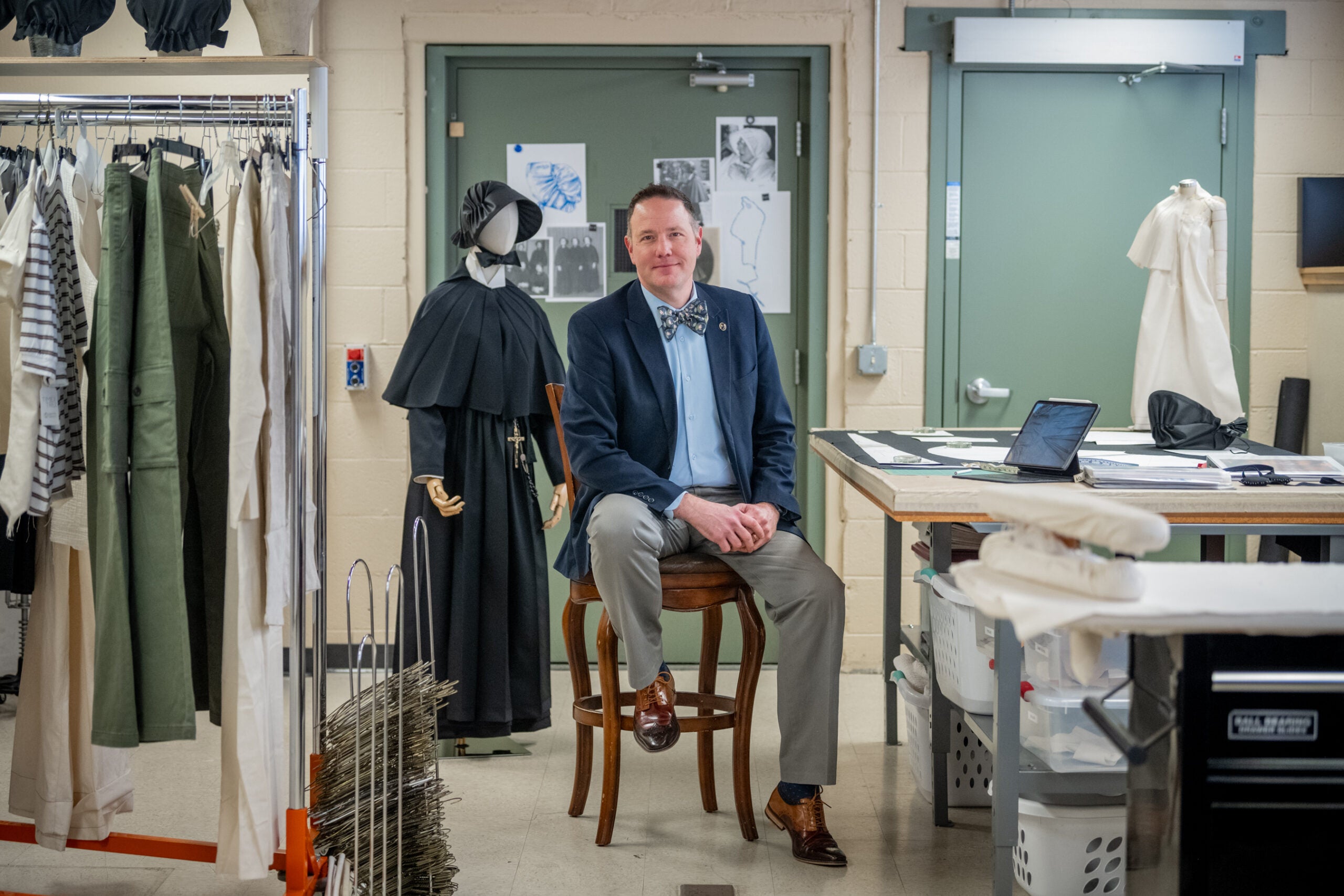
Pufall Purdy also has a long history with Shanley’s play. He first designed costumes for “Doubt” in 2009 in Upstate New York for a production starring Loretta Swit (best known from the iconic television show M*A*S*H) and again for a production at Boise State in 2018. For both, he relied on the internet and historic photos to recreate the best version he could of the traditional habit of the Sisters of Charity of New York – the full black skirt, short cape and fluted cap of the order founded by Sister Elizabeth Ann Seton, the first person born in the United States to be canonized.
“But I didn’t know the rules. Historic accuracy gets filtered. I have seen so many productions where costume designers get the habit wrong because the research isn’t readily available,” Pufall Purdy said, adding that in practice religious orders are specific about the elements of their habits. “These were their trademarks, their identity.”
For years, Pufall Purdy’s friends and colleagues asked him when he was going to write a book about traditional habits of women religious. In 2020, the pandemic put theatrical productions on hold. The time was right.
Stitches tell stories
Because of his familiarity with “Doubt,” Pufall Purdy reached out first to the Sisters of Charity of New York. The community invited him to the Bronx and, in 2021, with the help of a grant from the College of Arts and Sciences, he began his research. Pufall Purdy used the few remaining pieces of the historic habits in the order’s archive to create paper patterns and a faithful reproduction of the full garment. He consulted with Sister Elizabeth Vermaelen S.C., now in her 90s, who wore the habit for nearly two decades until 1968 when Vatican II allowed orders to adopt modern dress.
“Sister Vermaelen remembers everything, down to the stitch,” Pufall Purdy said.
That includes the “death tuck,” a six-inch fold of fabric sewn into a sister’s skirt that was unstitched when she died and folded over her feet in her coffin. Pufall Purdy recalled Sister Vermaelen’s words: “Shoes were expensive. We didn’t put them in the ground.” The sisters’ black caps also told stories. Professed sisters had five flutes in their caps, novices only four.
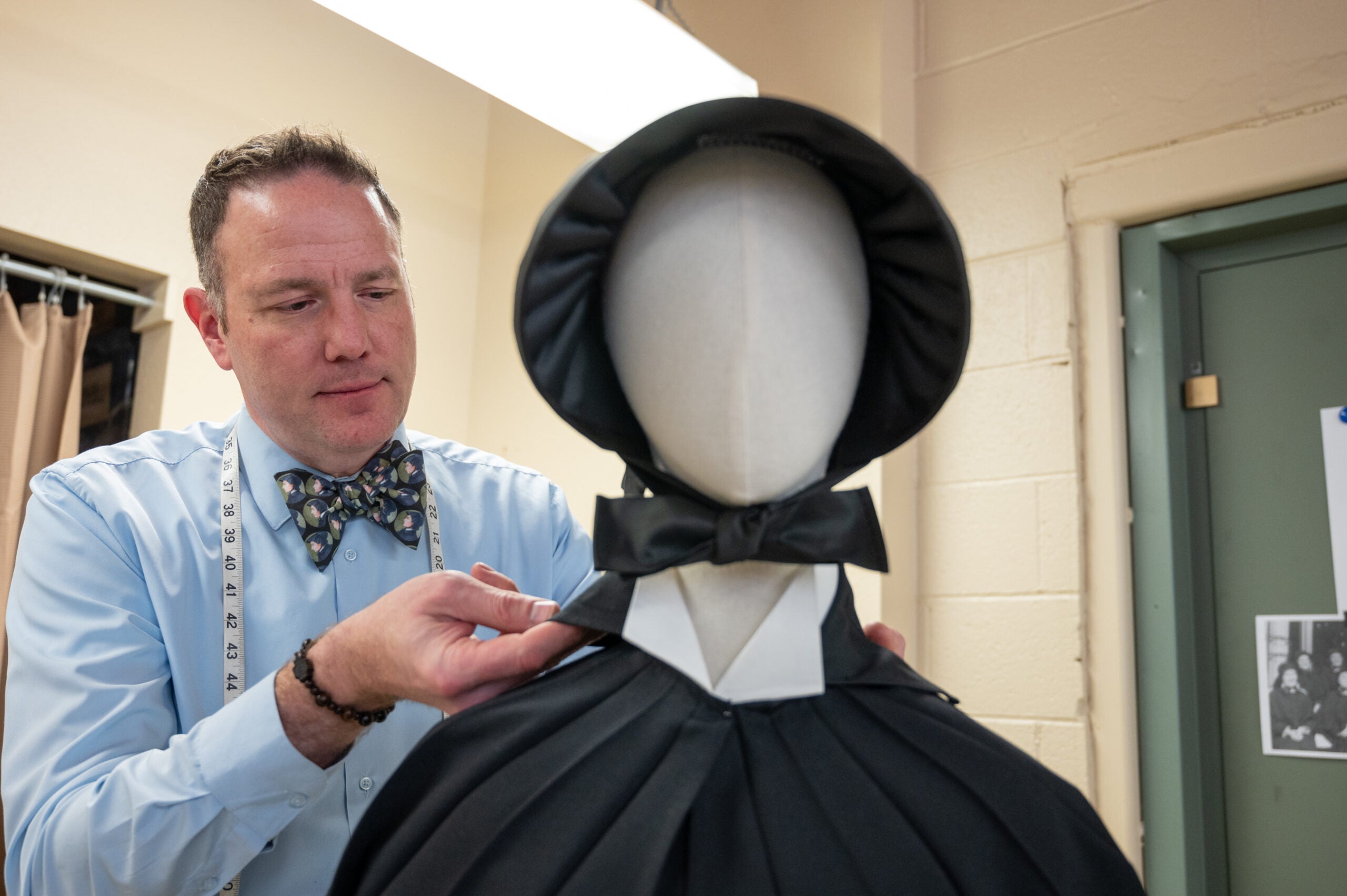
Stitches tell stories
Because of his familiarity with “Doubt,” Pufall Purdy reached out first to the Sisters of Charity of New York. The community invited him to the Bronx and, in 2021, with the help of a grant from the College of Arts and Sciences, he began his research. Pufall Purdy used the few remaining pieces of the historic habits in the order’s archive to create paper patterns and a faithful reproduction of the full garment. He consulted with Sister Elizabeth Vermaelen S.C., now in her 90s, who wore the habit for nearly two decades until 1968 when Vatican II allowed orders to adopt modern dress.
“Sister Vermaelen remembers everything, down to the stitch,” Pufall Purdy said.
That includes the “death tuck,” a six-inch fold of fabric sewn into a sister’s skirt that was unstitched when she died and folded over her feet in her coffin. Pufall Purdy recalled Sister Vermaelen’s words: “Shoes were expensive. We didn’t put them in the ground.” The sisters’ black caps also told stories. Professed sisters had five flutes in their caps, novices only four.
Bronco talent on stage
Pufall Purdy’s research made him an expert on the way the Sisters of Charity once dressed. So, when the producers of the New York revival of “Doubt” contacted the order in summer 2023, the sisters sent them to Pufall Purdy.
Tony Award-winning costume designer Linda Cho hired him to create a habit for a photo shoot with Tyne Daly (who starred in the 1980s police drama “Cagney and Lacey”). He received Daly’s measurements on a Friday and, working around the clock, sent the finished garment to New York City on Monday. Thanks to his tailoring skills and assistance from student Michelle Montanus, a senior theatre arts major from Meridian, Idaho, the costume fit Daly perfectly. The producers soon asked Pufall Purdy to make the sisters’ garments for the production. Montanus and alum Grace Slaughter (BA, theatre arts, 2018), are assisting.
Slaughter, born and raised in Boise, has worked as a stitcher with Pufall Purdy for eight years.
“There is something about creating a garment that is so distinct to a group of people that feels more high pressure,” Slaughter said. “It’s been a lot of pleating, gathering, sleeves, cuffs and collars. All very simple, yet meticulous and important.”
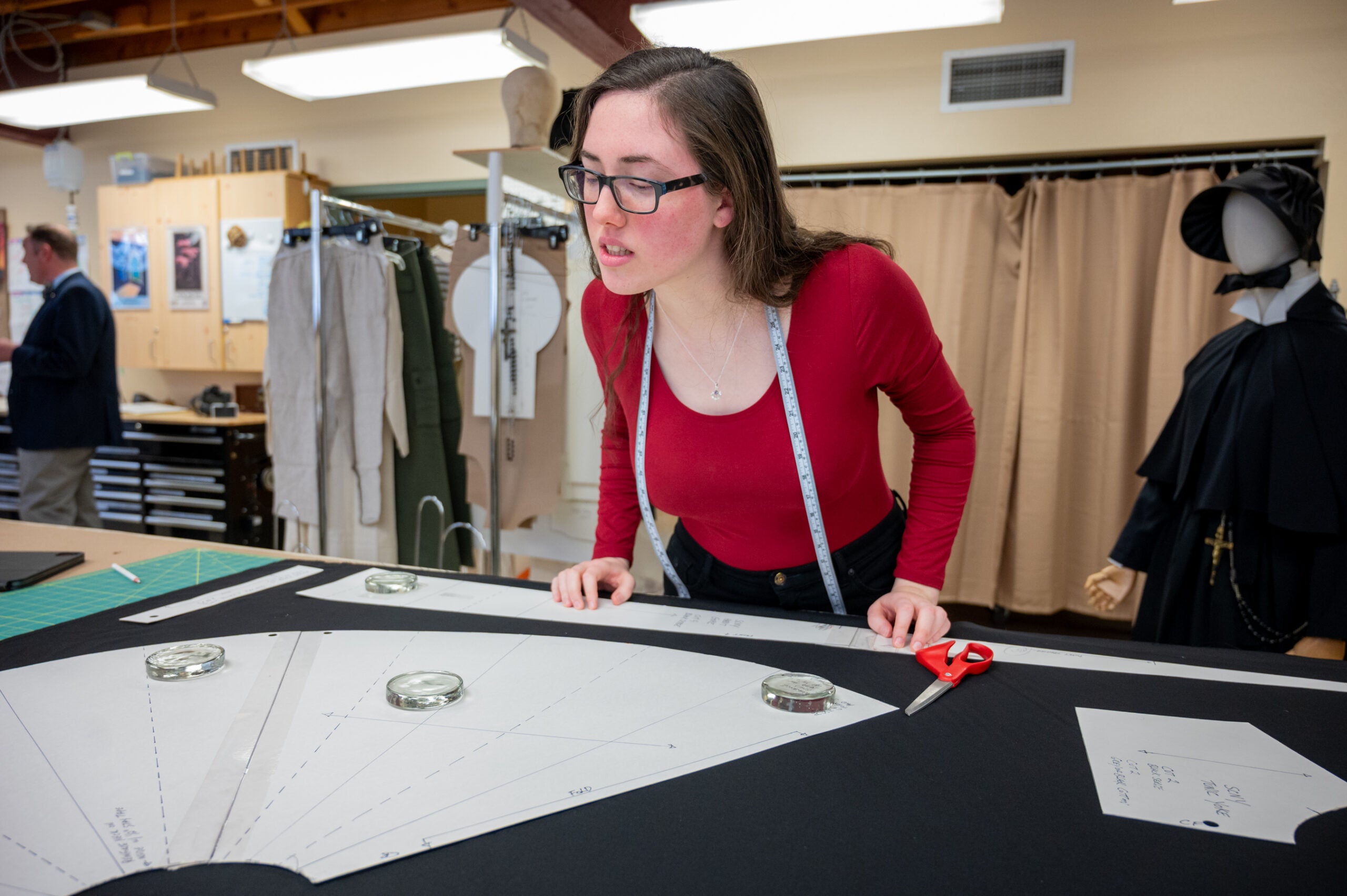
Montanus’ description of being part of a Broadway production? “Surreal.”
“As a student and as someone in Boise, Idaho, this opportunity is an incredible blessing,” said Montanus, who learned to sew from her mother, and, in addition to her work on campus, sews costumes for Ballet Idaho and the Idaho Shakespeare Festival.
“I can earn a Broadway salary right here. And it’s a big gold sticker on my resume. I grabbed the opportunity with both hands,” she said.
Professional-level work by students and alumni sustains Boise State’s program, Pufall Purdy said, noting that several of his former students teach theatre arts or work on Broadway. That includes costume designer Benjamin Weigel (BA, French, 2014), originally from Twin Falls, Idaho. Weigel, in a small world twist, is a design assistant for the New York “Doubt” revival.
“I tell my students, ‘don’t forget me when you’re famous,’” Pufall Purdy said.
Outreach, connection, community
Pufall Purdy’s work with the Sisters of Charity of New York is a springboard for further research to complete his book. Several orders have agreed to work with him, including the Missionary Sisters of the Sacred Heart of Jesus in New York City, the Oblate Sisters of Providence in Baltimore, Maryland – the first U.S.-based religious order of women of color – the Sisters of the Blessed Sacrament in Philadelphia, Pennsylvania, and others.
As he did for the Sisters of Charity, Pufall Purdy will gift each order with a full, recreated historic habit and patterns that will eventually be available to designers, scholars and researchers.
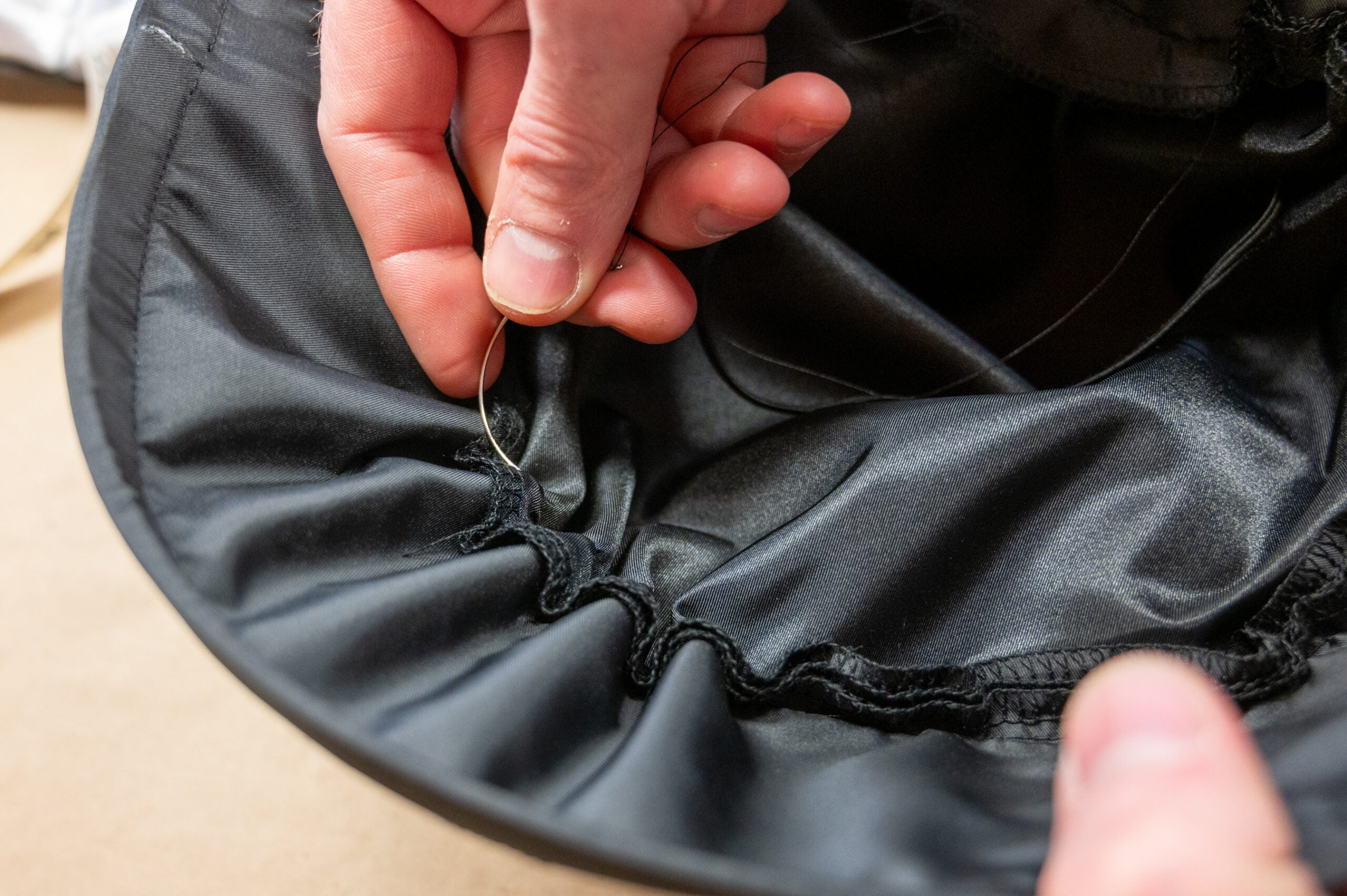
“This experience has evolved into a deeply personal journey, blending my artistic passion with the spiritual values ingrained in me from a young age,” Pufall Purdy said. “Beyond costume design, this work serves as a tribute to those devoted to a life of service. Creating the iconic habits for the first Broadway revival of “Doubt” expresses my respect for the sisters, allowing me to reflect on the person I’ve always been — a believer in faith, community, and the art of storytelling.”
Mindy Gordon, director of the Archives at Elizabeth Boyle Hall, Sisters of Charity of New York, said that working with Pufall Purdy was the highlight of her career.
“He’s doing something for the congregation without asking anything in return. Something that fills a void,” Gordon said. Pufall Purdy’s generosity in time and expertise, she said, “is the definition of an academic and a scholar.”
More about the Sisters of Charity of New York
Elizabeth Seton was born into a prominent Episcopalian family in New York City in 1774. After her husband died in Italy of tuberculosis – the family had relocated, hoping the mild climate would heal him – Seton returned to America, converted to Catholicism and founded the Sisters of Charity of St. Joseph in Emmitsburg, Maryland in 1809. She drew inspiration for the order’s habit from traditional Italian widows’ attire, practical dress for the sisters as they served the poor, the sick and others on the edges of society.
In 1817, Seton sent a group of sisters to New York City, laying the foundation for the Sisters of Charity of New York. The sisters established St. Vincent’s Hospital in Greenwich Village in 1849. The hospital operated for 160 years, tending to patients through crises – epidemics, the sinking of the Titanic, the attack on 9/11. “They were at ground zero for the AIDS epidemic,” Pufall Purdy said. “These sisters met people where they were.”
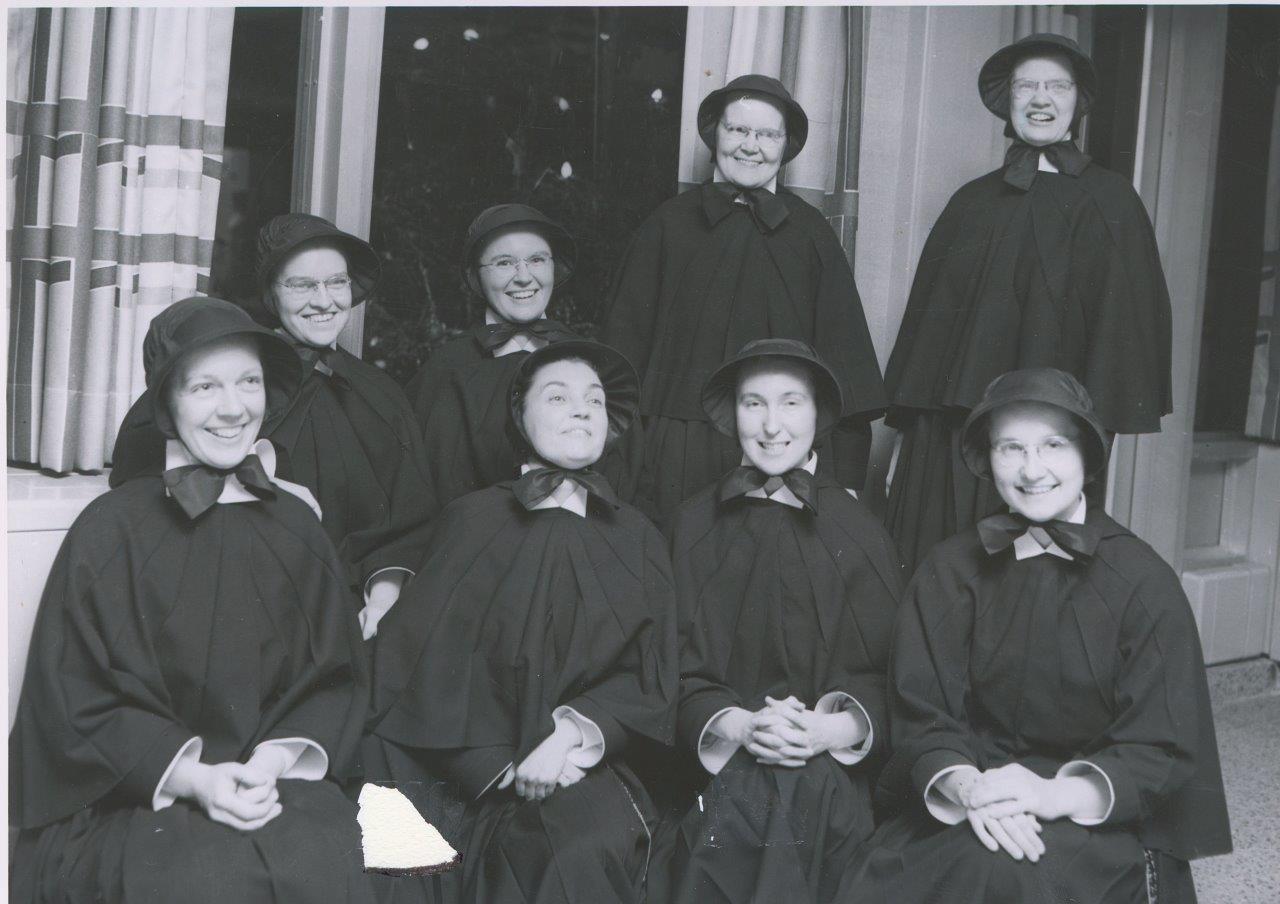
The order’s leadership announced in 2023 that it will no longer accept new members.
“The sisters are starting the process called ‘coming to completion,’” Pufall Purdy said. “Which sounds so sad. But what that says is that, ‘We’ve done what we came to do.’ And it’s pretty amazing what they have done in their 250-year history.”
Research: On the road
When Pufall Purdy travels for onsite visits, he carries a backpack that contains:
- a large felt mat for pinning garments
- pins, tacks and needles
- paper for making notes and detail drawings
- pens, pencils, marking tools, tailors’ chalk
- thread/silamide (waxed thread)
- ponce or tracing wheel
- scissors, snips, seam rippers, rotary cutting blades
- brown paper for making patterns
- Swiss pattern paper
- glass pattern weights
- a canvas head form (like a wig head)
- rulers, curves, hem gauges and tape measures
- a Leatherman tool
- a portable LED light
- a portable steamer
- a mini iron
- archival gloves for handling extant garments and objects
- an ipad to take “tons” of photos
“Depending on what stage I am in the process, I will coordinate having a dress form on-site as well,” Pufall Purdy said. He recently bought new luggage that can carry a form in case he has to bring his own.
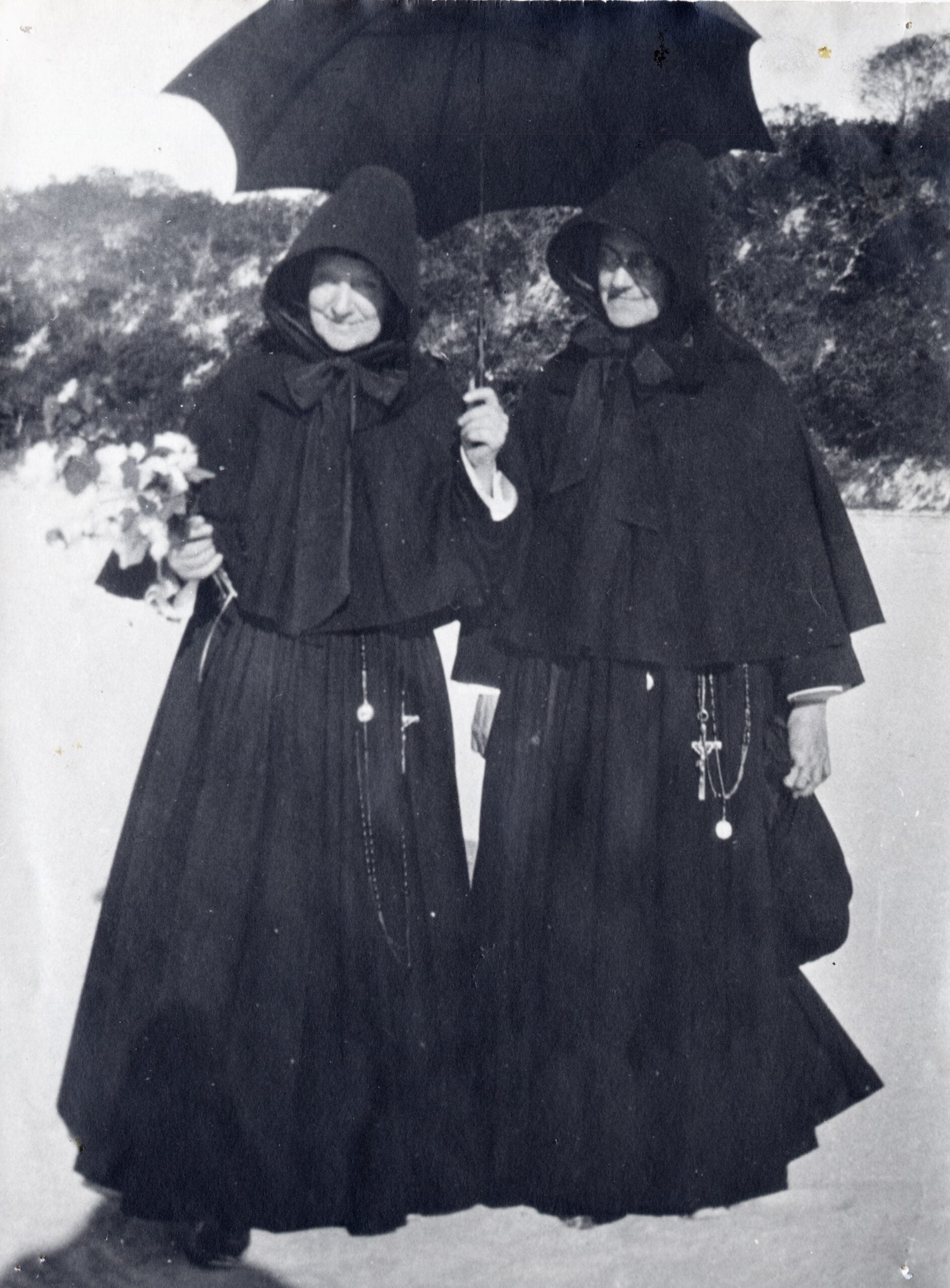
*Note
Since the publication of this story, Tyne Daly has withdrawn from the production of “Doubt” because of health reasons. Amy Ryan will replace her in the role of Sister Aloysius Beauvier.
Video Transcript
(light music)
[Darrin Pufall Purdy, Associate Professor of Theatre Arts, Specialization in Costume Design]: Doubt is a play written by John Patrick Shanley. It premiered on Broadway in 2005. It is getting its first Broadway revival in February of 2024 this year. I got involved with Doubt through my work with the Sisters of Charity of New York. I had been working with them for roughly three years to document the particulars of their specific habit, which is prominently featured in John Patrick Shanley’s play Doubt. This research led me to collaborate with the design team and share my research, which then eventually culminated in an invitation to work on the production itself. There’s a severe lack of resources for designers when looking for research that depicts religious life and the clothing worn by those that live a religious life: nuns, monks, friars, etc.. There’s a hole in this kind of subject. For many years, these orders were so secretive about how their garments were constructed and maintained. Now that we are in the 21st century, a lot of these orders are dying out. They’re coming to completion as they say, and they are now ready to share those secrets with the world. Working with the Sisters of Charity of New York allowed me to create a full and complete pattern. Up until now, there has been no pattern documentation for their specific habit. Their archives contain pieces and parts of different sister’s habits, so there isn’t one complete habit in the archive. Things are moth eaten and they are falling apart rapidly. So it has become very urgent that this information be documented. Everything I do is geared toward my students. It’s one of the great privileges of my life to be able to work with the Sisters of Charity of New York, but also to take my students with me on this journey.
(sewing machine)
[Michelle Montanus, Theatre Arts Major]: Having Broadway on my resume is surreal, and bizarre and unreal, and I don’t think I’ll quite believe it until I see it on Broadway. Gee, it’s a gold sticker on my resume and it makes me wish I was really Broadway-bound because that is definitely a foot in the door. But I think it’s going to help me greatly wherever I choose to go in my career.
(scissors cutting)
[Darrin]: It has become so much more than a costume project for me. It started out that way, as a costume designer I was seeking proper research for characters on stage, but what I found is that documenting these specifics for these orders is actually about Catholic history, women’s history, fashion history. So much more than a costume project.
(music swells and fades)
